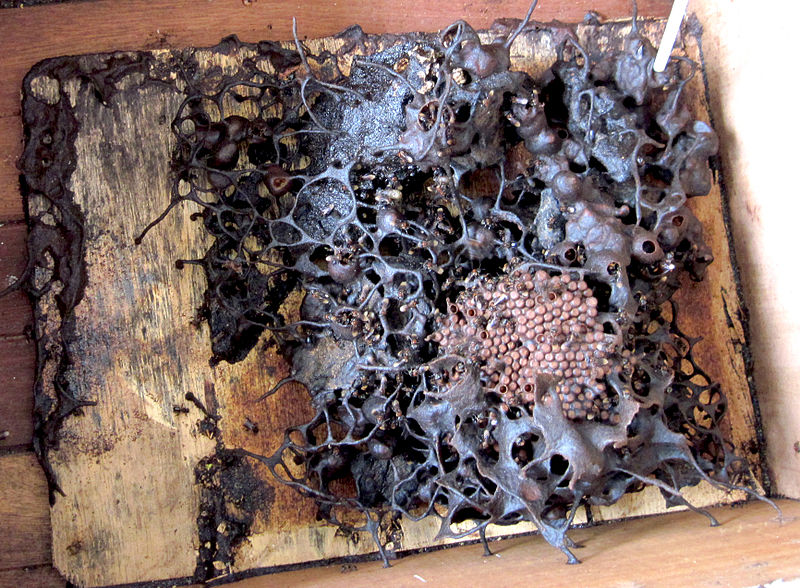Honey is a popular food and not only here in Germany, but worldwide. It is a delicacy and the many varieties from around the world are all popular. As a beekeeper, bee researcher, and honey lover, I am of course always looking for rare and special honey that I don’t know yet. In the meantime, it is often the western honeybee Apis mellifera that has become globalized livestock through humans, to which we owe the precious honey. Originally native to Europe, Apis mellifera has meanwhile largely displaced the honey bee species (Apis spp.) Originally native to other parts of the world from agriculture. Most honey, no matter where it comes from, now comes from this one western honey bee species. However, since each species has its own properties that are adapted to the respective region, the honey also differs slightly from species to species, even if it comes from the same region. Different species have different abilities to visit certain flowers or not. As a result of this globalization, a large part of the honey diversity is lost. So if you are looking for special honey, you should fall back on beekeepers who keep the original bees of their region.

But this is exactly where things get difficult. By that, I mean less the problems of locating such contacts and more the legal obstacles. What honey is and can be marketed as honey is clearly defined by law. In many (European) countries, only honey from the western honey bee Apis mellifera is allowed to be labeled and marketed as honey. This completely rules out the honey of all other honey bee species native to other parts of the world. In Germany, the wording is a little more revealing: According to the German Honey Ordinance, only honey from honey bees, i.e. bees of the Apis genus, may be referred to and marketed as honey. That includes at least the other honey bee species, but that’s not enough for real honey lovers either. There are other bees that produce honey: the meliponini. This tribe within the Apidea family (real bees) includes various genera of small, stingless bees that also form states and produce honey. They are prevalent pantropically in South and Central America as well as Australia. But there are also a few of these stingless bee species in Asia and Africa. Of course, the honey from these bee colonies has been traditionally used by local people for a long time. In modern times, stingless bees are even more and more used in small-scale farming. The small colonies can be kept in simple hives and therefore require little further equipment. As native species, they are much more robust and disease-resistant than the introduced honeybee species. Therefore, the Meliponini colonies are much more affordable for the often poor rural population than the expensive modern beehives with the western honeybees, which are overbred and often susceptible to diseases outside their endemic home. But in many countries, especially in the EU, this honey is not honey within the meaning of the respective honey regulations. It may not be marketed or put on the market as honey. So there is clearly enough of honey discrimination here. After all, it is honey that is also produced by bees and there is no reason to deny them their right to honey production just because they belong to a different species or genus. We should refrain from such ideas very quickly …

The question arises, of course, how broadly one can grasp the term honey. Some bumblebee species (Bombus spp.) that form the state also produce honey and even some wasp species (Vespidae or Masarinae), and this too has a long tradition of human use. In general, honey in biology is a sugar-containing substance made by insects from sugar-containing plant nectar or honeydew, the sugar-containing excretions of plant sap-sucking insects, by adding endogenous enzymes and then strongly thickened by removing the water content. At least according to this view, the stingless bees, the state-forming bumblebees, and honey wasps also produce honey. The restriction in food law means that these original and endemic honey producers (regardless of whether they are bees, honeybees, bumblebees, or wasps) are increasingly being displaced by globalized agriculture with uniform livestock species around the world. Some of these already endangered species have a high risk of dying out due to this exclusion and could soon be completely vanished from the earth. In terms of biodiversity and environmental protection, this is of course a disaster. Innovation in food law should therefore urgently be considered.
Text: Fabian Kalis
Image source: Mohamad Izham M.A, Ma Hzi Wong at Malay Wikipedia, CC BY-SA 3.0 <https://creativecommons.org/licenses/by-sa/3.0>, via Wikimedia Commons unten: José Reynaldo da Fonseca, CC BY-SA 3.0 <http://creativecommons.org/licenses/by-sa/3.0/>, via Wikimedia Commons